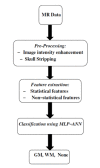An Automated MR Image Segmentation System Using Multi-layer Perceptron Neural Network
- PMID: 25505757
- PMCID: PMC4204503
An Automated MR Image Segmentation System Using Multi-layer Perceptron Neural Network
Abstract
Background: Brain tissue segmentation for delineation of 3D anatomical structures from magnetic resonance (MR) images can be used for neuro-degenerative disorders, characterizing morphological differences between subjects based on volumetric analysis of gray matter (GM), white matter (WM) and cerebrospinal fluid (CSF), but only if the obtained segmentation results are correct. Due to image artifacts such as noise, low contrast and intensity non-uniformity, there are some classification errors in the results of image segmentation.
Objective: An automated algorithm based on multi-layer perceptron neural networks (MLPNN) is presented for segmenting MR images. The system is to identify two tissues of WM and GM in human brain 2D structural MR images. A given 2D image is processed to enhance image intensity and to remove extra cerebral tissue. Thereafter, each pixel of the image under study is represented using 13 features (8 statistical and 5 non- statistical features) and is classified using a MLPNN into one of the three classes WM and GM or unknown.
Results: The developed MR image segmentation algorithm was evaluated using 20 real images. Training using only one image, the system showed robust performance when tested using the remaining 19 images. The average Jaccard similarity index and Dice similarity metric for the GM and WM tissues were estimated to be 75.7 %, 86.0% for GM, and 67.8% and 80.7%for WM, respectively.
Conclusion: The obtained performances are encouraging and show that the presented method may assist with segmentation of 2D MR images especially where categorizing WM and GM is of interest.
Keywords: Artificial neural networks; Image segmentation; Multi-layer perceptron.
Figures




Similar articles
-
3D cerebral MR image segmentation using multiple-classifier system.Med Biol Eng Comput. 2017 Mar;55(3):353-364. doi: 10.1007/s11517-016-1483-z. Epub 2016 May 20. Med Biol Eng Comput. 2017. PMID: 27207464
-
Learning-based 3T brain MRI segmentation with guidance from 7T MRI labeling.Med Phys. 2016 Dec;43(12):6588-6597. doi: 10.1118/1.4967487. Med Phys. 2016. PMID: 28054724
-
Automatic segmentation of MR brain images of preterm infants using supervised classification.Neuroimage. 2015 Sep;118:628-41. doi: 10.1016/j.neuroimage.2015.06.007. Epub 2015 Jun 7. Neuroimage. 2015. PMID: 26057591
-
A reliable spatially normalized template of the human spinal cord--Applications to automated white matter/gray matter segmentation and tensor-based morphometry (TBM) mapping of gray matter alterations occurring with age.Neuroimage. 2015 Aug 15;117:20-8. doi: 10.1016/j.neuroimage.2015.05.034. Epub 2015 May 21. Neuroimage. 2015. PMID: 26003856
-
A New Optimized Thresholding Method Using Ant Colony Algorithm for MR Brain Image Segmentation.J Digit Imaging. 2019 Feb;32(1):162-174. doi: 10.1007/s10278-018-0111-x. J Digit Imaging. 2019. PMID: 30091112 Free PMC article. Review.
Cited by
-
Improving across-dataset brain tissue segmentation for MRI imaging using transformer.Front Neuroimaging. 2022 Nov 21;1:1023481. doi: 10.3389/fnimg.2022.1023481. eCollection 2022. Front Neuroimaging. 2022. PMID: 37555170 Free PMC article.
References
-
- Pham DL, Xu C, Prince JL. Current Methods in Medical Image Segmentation. Annu Rev Biomed Eng. 2000;2:315–37. Review. PubMed PMID: 11701515. - PubMed
-
- Apostolova LG, Dinov ID, Dutton RA, Hayashi KM, Toga AW, Cummings JL, et al. 3D comparison of hippocampal atrophy in amnestic mild cognitive impairment and Alzheimer's disease. Brain. 2006;129:2867–73. doi: 10.1093/brain/awl274. PubMed PMID: 17018552. - PubMed
-
- Lawrie SM, Abukmeil SS. Brain abnormality in schizophrenia. A systematic and quantitative review of volumetric magnetic resonance imaging studies. British J Psychiatry. 1998;172:110–20. PubMed PMID: 9519062. - PubMed
LinkOut - more resources
Full Text Sources
